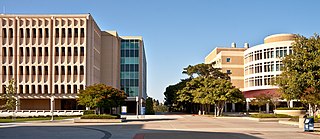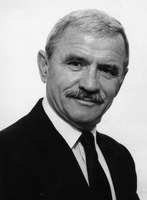
Lyman Spitzer Jr. was an American theoretical physicist, astronomer and mountaineer. As a scientist, he carried out research into star formation, plasma physics, and in 1946, conceived the idea of telescopes operating in outer space. Spitzer invented the stellarator plasma device and is the namesake of NASA's Spitzer Space Telescope. As a mountaineer, he made the first ascent of Mount Thor, with Donald C. Morton.
An academic department is a division of a university or school faculty devoted to a particular academic discipline. This article covers United States usage at the university level. In the United Kingdom and other Commonwealth countries, universities tend to use the term faculty; faculties are typically further divided into schools or departments.

The Texas A&M College of Science is the science college of Texas A&M University in College Station. The faculty includes a Nobel laureate and three National Academy of Sciences members. In 2006, the faculty collected a combined $38.5 million in peer-reviewed federal funding, and annually generates over $5 million in indirect cost return for Texas A&M.
Russell Earl Marker was an American chemist who invented the octane rating system when he was working at the Ethyl Corporation. Later in his career, he went on to found a steroid industry in Mexico when he successfully made semisynthetic progesterone from chemical constituents found in Mexican yams in a process known as Marker degradation. This eventually led to the development at Syntex of the combined oral contraceptive pill and synthetic cortisone - and to the development of the Mexican barbasco trade.
The College of Letters and Science (L&S) is the largest of the 14 colleges at the University of California, Berkeley and encompasses the liberal arts. The college was established in its present state in 1915 with the merger of the College of Letters, the College of Social Science, and the College of Natural Science. As of the 2013–14 academic year, there were about 19,000 undergraduates and 2,763 graduate students enrolled in the college. The College of Letters and Science awards only Bachelor of Arts degrees at the undergraduate level, in contrast to the other schools and colleges of UC Berkeley which award only Bachelor of Science degrees at the undergraduate level.
The University of British Columbia (UBC) is a Canadian public research university with campuses in Vancouver and Kelowna, British Columbia. The following is a list of faculties and schools at UBC.

The Faculty of Science is the largest of six faculties at McMaster University in Hamilton, Ontario, Canada. Founded in 1962, the faculty is located in the Westdale neighbourhood. It houses 6,800 undergraduate students and 600 graduate students, across 39 upper-year undergraduate programs ranging from astrophysics, biochemistry, earth and environmental sciences, to life sciences, human behaviour, kinesiology and medical and radiation sciences. Notable discoveries at McMaster University include the development of neutron spectroscopy by Bertram Brockhouse which earned him a Nobel Prize in Physics in 1994.
The Penn State College of Information Sciences and Technology, also known as the College of IST, opened in 1999 as the information school of The Pennsylvania State University. Headquartered at the University Park campus in University Park, Pennsylvania, the college's programs are offered at 18 Penn State campus locations. Dr. Andrew Sears currently serves as the college's dean.
Oregon State University's College of Science is a college within Oregon State University consisting of 7 departments offering 9 undergraduate programs and houses 7 PhD granting programs and 8 Master's degree granting programs. The college also offers classes for interdisciplinary science programs housed in other colleges. The college was founded in 1932 as the School of Science, when the OSU paleontologist Earl L. Packard became the first dean, as a result of the dramatic reorganization of the Oregon State System of Higher Education in the same year. The School of Science was renamed to the College of Science in 1974. The current dean is Roy Haggerty.

The College of Sciences at the University of Texas at San Antonio is a college in research and science education. The college hosts more than 5000 students enrolled in fifteen undergraduate and sixteen graduate programs. The seven departments employ 286 tenure and non-tenure track faculty members. Students are exposed to collaboration through programs with local external research institutions including UT Health Science Center, Southwest Research Institute and the Southwest Foundation for Biomedical Research.
Academics at the Massachusetts Institute of Technology are organized into 6 divisions containing 32 academic departments or faculties along with many interdisciplinary, affiliated, and intercollegiate research and degree programs. The Schools of Engineering, Science, Sloan School of Management, Humanities, Arts, and Social Sciences, Architecture and Urban Planning, and the Whitaker College of Health Sciences and Technology.

The School of Physical Sciences is an academic unit of the University of California, Irvine (UCI) that conducts academic research and teaching in the field of physical sciences. It offers both pre-professional training and general education in the departments of chemistry, earth system science, mathematics, and physics and astronomy. The school enrolls 1,400 undergraduate and graduate students and is one of the top schools in the nation in the number of degrees it confers in the area of physical sciences. It also offers specializations such as biochemistry, statistics, math for economics, applied and computational mathematics, astrophysics, applied physics, biomedical physics, and education. In 1995, the school gained international prominence when Frank Sherwood Rowland, a professor in chemistry and Frederick Reines, a professor in physics, won the Nobel Prize in their respective fields. It was the first time two people won the prize in the same year in two different fields at the same public university.
The Faculty of Science and Engineering (FES) is one of the four faculties that comprise the University of Manchester in northern England. Established in October 2004, the faculty was originally called the Faculty of Engineering and Physical Sciences. It spans a range of "discipline areas" consisting of the Schools of Chemical Engineering and Analytical Science; Chemistry; Petroleum Engineering; Computer Science; Earth, Atmospheric and Environmental Science; Physics and Astronomy; Electrical & Electronic Engineering; Materials; Mathematics; and Mechanical, Aerospace and Civil Engineering.

The College of Natural Science (NatSci) at Michigan State University is home to 29 departments and programs in the biological, physical and mathematical sciences.

The College of Engineering (CoE) is one of the three undergraduate colleges at the University of California, Santa Barbara.

Verne M. Willaman was a business executive and philanthropist. He was chairman and president of pharmaceutical firm Ortho Pharmaceutical Corporation and director and member of the executive committee of Johnson & Johnson.
Nitin Samarth is an American physicist, currently the George A. and Margaret M. Downsbrough Department Head and Professor of Physics in the Eberly College of Science, Pennsylvania State University.

The College of Science at the University of Utah is an academic college of the University of Utah in Salt Lake City, Utah. The college offers undergraduate and graduate degrees in Biology, Chemistry, Mathematics, Physics, and Astronomy.
Pierre Vsevolod Sokolsky is an American physicist, currently a Distinguished Professor of Physics and Astronomy and Dean Emeritus of the University of Utah College of Science and also a Fellow of the American Physical Society.








